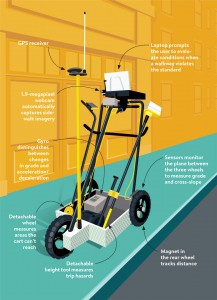New gadget gauges sidewalk compliance
A seemingly simple three-wheeled device — Wired calls it a “magic cart” — may make America’s sidewalks safer for the disabled. Created by Peter Axelson, who has used a wheelchair since 1975, the device is programmed with federal, state and local disability regulations. A worker runs the device, formally known as Prowap, or Public Rights-of-Way Assessment Process, through a given area; Prowap’s sensors make note of any rules broken in the area.

Illustration by Brown Bird Design, via Wired.
Axelson explained to Wired how the Prowap works: “We roll, hit the button, and boom! We get measurements in 10 to 20 percent of the usual time.” The traditional method for charting these sidewalk safety rule-breakers? Workers have to get down on hands and knees to measure cracks and ramps with measuring sticks.
The Prowap assessment addresses four key areas: tripping hazards, curb ramps, cross slopes, and critical features, helping city planners and officials begin the process of meeting the Access Board Public Rights of Way Guidelines. Those Guidelines, which will address “pedestrian access to sidewalks and streets, including crosswalks, curb ramps, street furnishings, pedestrian signals, parking, and other components of public rights-of-way,” will be adopted first by the Department of Justice before becoming enforceable under the ADA.
Specifically, Prowap is equipped with a graphical user interface, a Structured Query Language (SOL) data structure, and a “report generator to facilitate the creation of Americans with Disabilities Act (ADA) transition plans,” as well as Geographic Information System (GIS) mapping tools, to “build sidewalk mapping layers,” according to the grant award information.
There are many ADA accessibility standards for design, spanning state and local government facilities as well as public and commercial accommodations. You can read more about the ADA’s specific guidelines online here. The Prowap is programmed to gauge sidewalks by all relevant standards, based on the area it is used in.

A new device, the Prowap, is about to make ADA compliance cheaper and vastly easier. From Salim Virji.
In addition to assisting those dependent on wheelchairs, the project will also aid city planners and engineers, who require “detailed assessments of public rights-of-way to evaluate existing conditions, determine compliance with draft accessibility guidelines, and plan reconstruction projects.” The existing method for analyzing accessibility is both time- and resource-consuming.
Axelson, with his Santa Cruz, California-based company, Beneficial Designs, received a grant to develop methods for measuring sidewalk compliance with the 1990 Americans with Disabilities Act back in 2008. (You can read more about the original ADA, as well as its various amendments, online, here.) The product of their grant is the Prowap, which was recently launched to measure and analyze sidewalks in Gardnerville, Nevada.
Axelson, who suffered a spinal cord injury while in the Air Force Academy, has long been interested in improving standards and accessibility for the disabled. After earning a BS in ME and Product Design and a MSME in Smart Product Design from Stanford, he stared Beneficial Designs “when I realized people could benefit from the sit-ski I had created for myself.”
As a Stanford Fellow, he wrote of his company’s focus, “We work towards universal access through research, design, and education. We believe all individuals should have access to the physical, intellectual, and spiritual aspects of life.” Some of Axelson’s related work includes developing a chairlift-compatible mono-ski with a shock absorber, developing wheelchair seating, and establishing the Universal Trail Assessment Process, which analyzes outdoor trails to improve their accessibility for the disabled.
Category: Enforcement, Infrastructure, News & New Products, Uncategorized


















